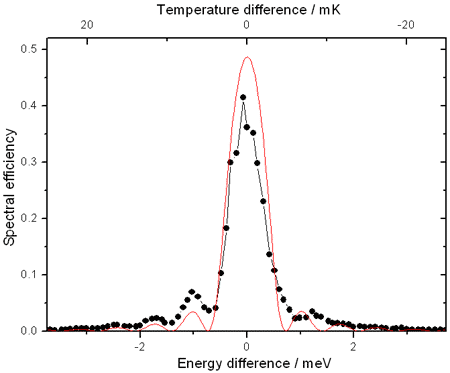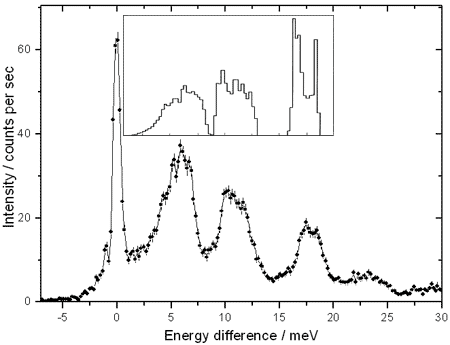- Home
- News
- Spotlight on Science
- Sub-meV sapphire...
Sub-meV sapphire crystal X-ray monochromator
14-04-2011
High efficiency nuclear inelastic scattering measurements above 30 keV with sub-meV resolution are now possible through the use of a sapphire backscattering monochromator in combination with improvement of the upstream X-ray optics at beamline ID18. This development will permit detailed lattice dynamics characterisations of novel functional materials based on elements such as tellurium.
Share
Sub-meV monochromatisation of X-rays with high efficiency is a keystone for inelastic scattering techniques such as inelastic X-ray scattering or nuclear inelastic scattering. Typically, meV monochromatisation is performed by diffraction on silicon crystals in backscattering geometry or by using a multiple crystal arrangement. Silicon is the material of choice, as large ingots of extremely good quality are available. However, both of these approaches encounter difficulties above 30 keV if monochromatisation at a specific energy is required. Backscattering from a crystal with lower symmetry than silicon, i.e. with a large spectral density of back reflections, may overcome these difficulties [1]. In principle, sapphire is a good candidate material, which could provide efficient monochromatisation for any energy above 20 keV by the proper choice of reflection and variation of the reticular distance with temperature. However, even the best available sapphire crystals have insufficient quality that strongly restricts their application in X-ray optics [2].
Here, an approach is presented which demonstrates that an almost ideal performance can be achieved even with imperfect sapphire crystals. At beamline ID18, the synchrotron radiation beam was focused to 0.2 x 0.2 mm2 at the crystal position and a sapphire with a limited thickness of about 1 mm was utilised. Also involved was a cryostat for the backscattering monochromator, which was an in-house development [4]. The part of the crystal with the best quality was selected and used as a monochromator. A test of the monochromator was performed at 35.492 keV, the nuclear resonance energy of 125Te, using the (9 1 10 68) sapphire reflection. At a sapphire temperature of 219.48(1) K, the backscattered radiation matches the nuclear resonance energy. The instrumental function was measured by recording the time integrated nuclear forward scattering, see Figure 1. An energy resolution of ~0.7 meV (FWHM) and spectral efficiency of ~35% were obtained, close to the theoretical reflectivity for this crystal thickness. The relative energy resolution E/ΔE = 0.5×108 directly corresponds to the number of diffraction planes in the crystals. The good quality of the reflection is also confirmed by the visible Pendellösung fringes due to the interference between the radiation reflected from the front and the back crystal surface.
With a ring current of 100 mA, a photon flux of 2×108 photons/s was obtained by using this monochromator. This level of flux allows time efficient measurements of nuclear inelastic scattering to be carried out for compounds containing Te. The inelastic scattering of elemental Te was measured and subtle fine structure could be resolved owing to the good resolution, see Figure 2. These results open the field of nuclear inelastic scattering for many functional materials bearing Te, such as phase-change materials, thermoelectric materials, photovoltaic semiconductors and iron-chalcogenide superconductors.
Authors
I. Sergueev (a), H.-C. Wille (b), R.P. Hermann (c,d), D. Bessas (c,d), Yu.V. Shvyd’ko (e) and R. Rüffer (a)
(a) ESRF
(b) DESY, Hamburg (Germany)
(c ) Jülich Center for Neutron Science JCNS and Peter Grünberg Institut PGI, JARA-FIT, Forschungszentrum Jülich GmbH, Jülich (Germany)
(d) Faculté des Sciences, Université de Liège (Belgium)
(e) APS, Argonne (USA)
References
[1] For a review see Y. Shvyd’ko, X-Ray Optics. High-Energy-Resolution Applications, Springer Berlin, 98 (2004).
[2] H.-C. Wille et al., Europhysics Letters 91, 62001(2010).
[3] J. Etchepare, P. Kaplan, M. Merian, in: Lattice Dynamics, ed. by M. Balkanski, Flammarion, Paris, p.60 (1978).
[4] P. van der Linden, H.-C. Wille, Yu. Y. Shvyd'ko, AIP Conference Proceedings 879, 915 (2007).
Top image: Checking the quality of a sapphire crystal in the X-ray beam. Its visible light fluorescence originates from impurities in the crystal.





